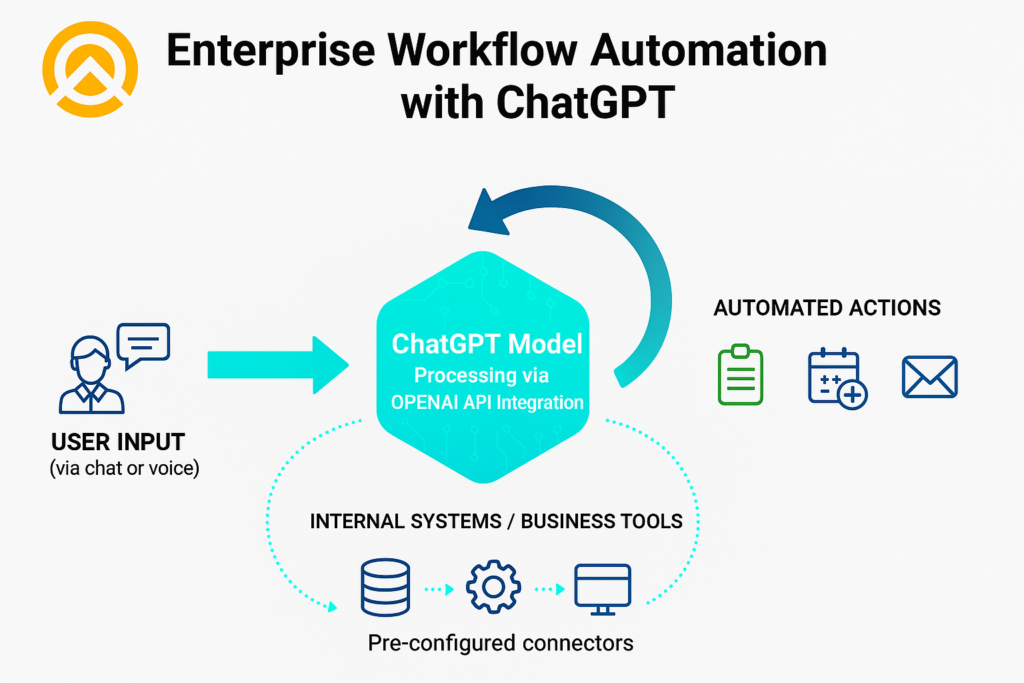ChatGPT Integration for Enterprises: How Companies Automate Workflows in 2026
Introduction
The year 2026 marks a defining moment in enterprise automation. After years of testing and fragmented AI adoption, conversational AI has become a central layer of business infrastructure. ChatGPT, in particular, has moved far beyond pilot projects; it’s now embedded in over 80% of Fortune 500 enterprise workflows, powering decisions, automation, and intelligent collaboration at scale.
Across industries, organizations are using ChatGPT to connect data, automate communication, and streamline complex operations. What once required dozens of manual processes can now be managed through systems that understand context, reason in real time, and adapt to business needs. From financial forecasting to supply chain visibility and customer engagement, enterprises are shifting toward intelligent automation that is both responsive and deeply integrated.
This blog explores how leading companies are using ChatGPT integration to automate workflows, reduce operational costs, and drive efficiency. It also breaks down practical architecture insights, real-world use cases, and what the next wave of enterprise automation could look like in the years ahead.
Understanding ChatGPT Integration Architecture
At the technical level, ChatGPT integration for enterprises involves a layered architecture designed for scalability, security, and interoperability. The framework allows enterprises to connect ChatGPT with existing platforms like CRMs, ERPs, HR tools, and analytics systems.
Core components include:
- OpenAI API layer: Provides access to GPT-based models for generating human-like responses and task automation.
- Enterprise data connectors: Bridge data sources such as databases, CMS, and knowledge bases.
- Workflow orchestration engine: Ensures the model interacts with the right application at the right time.
- Security and compliance layer: Manages encryption, user authentication, and data governance.
This multi-layered design ensures that workflow automation with ChatGPT can adapt to different enterprise ecosystems. Through well-structured AI integration services, it also maintains data security, compliance, and consistent performance across systems.
Enterprise Workflow Automation with ChatGPT
Enterprises are rapidly adopting ChatGPT integration for enterprises to create automated, intelligent workflows. Instead of manually handling repetitive tasks, companies now rely on conversational interfaces that can trigger actions, generate insights, and assist in real-time.

How it works technically:
- A user sends a request through chat or voice.
- ChatGPT processes the input via the OpenAI API integration.
- The model interacts with the enterprise’s internal systems through pre-configured connectors.
- Tasks such as data retrieval, scheduling, or customer support actions are automatically executed.
Example:
In a CRM integration, ChatGPT can fetch customer history, generate a follow-up email, and even schedule meetings, all within one conversation.
Benefits of ChatGPT Integration for Enterprises

Enterprises adopting ChatGPT integration enjoy several tangible advantages:
- Enhanced productivity: Automated workflows handle repetitive tasks such as data entry, report generation, and scheduling. Employees are freed to focus on higher-value work, allowing teams to deliver more in less time.
- Faster response times: ChatGPT processes requests in real time, enabling faster decision-making, immediate customer support, and instant internal knowledge retrieval. This accelerates business processes and reduces operational delays.
- Cost reduction: Automation reduces dependency on manual labor for routine tasks, cutting operational costs and minimizing human errors. Enterprises can reallocate resources toward strategic initiatives.
- Consistency: AI-driven processes standardize responses and actions across departments, ensuring reliability, compliance, and a uniform experience for both employees and customers.
- Improved decision-making: ChatGPT analyzes large datasets and generates actionable insights, enabling leadership and operational teams to make informed strategic decisions faster.
Also Read : How to Integrate AI into Your Existing Systems and Stay Competitive
Tools and Integration Methods
Enterprises can integrate ChatGPT using multiple approaches depending on scale, compliance needs, and IT infrastructure.
Integration Methods:
- OpenAI API integration: Enables direct interaction with GPT models through REST APIs or SDKs.
- Cloud deployment models: AWS, Azure, or Google Cloud for scalable, secure, and fast deployment.
- Conversational embedding: Embedding ChatGPT into CRMs, help desks, or web apps for seamless interaction.
Technical Tools:
- LangChain: Pipeline orchestration and multi-step reasoning.
- Zapier / Make: No-code automation for connecting apps and processes.
- Custom middleware: Ensures secure data exchange between enterprise systems.
How to Implement ChatGPT in Enterprise Systems
Successfully implementing ChatGPT integration requires close coordination between IT teams, business leaders, and end-users. A structured approach ensures workflows are accurate, secure, and aligned with business objectives.
1. Identify automation goals
Begin by assessing existing workflows to determine which tasks can benefit from AI-driven automation. Prioritize repetitive, high-volume processes where ChatGPT can create maximum impact.
2. Select an integration approach
Decide whether to use direct OpenAI API integration for custom solutions, a cloud deployment model for scalability, or a hybrid approach that combines multiple methods to meet specific enterprise needs.
3. Prepare data and connectors
Map internal databases, APIs, and third-party tools. Ensure data is clean, structured, and accessible to ChatGPT while maintaining compliance with privacy and governance protocols.
4. Develop and test workflows
Build AI-powered workflows and test them rigorously for accuracy, latency, and user experience. Validate that the model interacts correctly with all connected systems and handles edge cases effectively.
5. Deploy and monitor
Roll out ChatGPT-powered workflows gradually. Continuously monitor performance, track user interactions, and collect feedback. Regular updates and retraining ensure workflows remain efficient, secure, and aligned with evolving business requirements.
Also Read : Building a Scalable AI Integration Architecture: Frameworks, Patterns, and Best Practices
Challenges and Best Practices
Even with its potential, enterprises must overcome certain challenges during ChatGPT integration.
Common challenges:
- Data privacy and governance issues.
- Integration complexity with legacy systems.
- Limited awareness about model fine-tuning and customization.
- High initial deployment costs and resource allocation.
- Ensuring consistent performance across multiple departments and workflows.
Best practices:
- Use ChatGPT integration services with strong security and compliance protocols.
- Involve cross-functional teams for smoother adoption and better alignment.
- Regularly retrain models to align with evolving domain knowledge.
- Monitor AI outputs continuously to detect errors or biases early.
- Start with pilot workflows before scaling across the enterprise to ensure reliability and ROI.
These practices ensure that ChatGPT integration for enterprises remains stable, secure, and adaptable over time while maximizing business value.
Industry-Specific Use Cases of ChatGPT Integration
Enterprises across sectors are customizing ChatGPT integration to meet their operational needs. Let’s explore the key use cases.
1. E-commerce
E-commerce platforms use ChatGPT for product recommendations, intelligent search, and post-purchase engagement. The model understands user intent, suggesting personalized products or resolving order-related queries instantly.
2. Healthcare
In healthcare, ChatGPT integration services simplify complex administrative tasks. It supports medical staff by summarizing patient data, generating follow-up reminders, and improving appointment management.
3. Finance
Financial organizations use LLM integration solutions to streamline document management, compliance reporting, and fraud detection. ChatGPT assists analysts in extracting insights from structured and unstructured data, improving both accuracy and speed.
4. Education
Educational institutions integrate ChatGPT to enhance learning management, student support, and administrative processes. The AI can generate study materials, answer student queries, and assist faculty with grading and reporting.
5. Logistics
In logistics and supply chain management, ChatGPT improves operational visibility, shipment tracking, and customer communication. It can predict delays, optimize routes, and automate routine updates.
Also Read : The Role of AI Integration Consulting in Driving Scalable Digital Transformation
Why Partner with Amplework for ChatGPT Integration
Amplework transforms how enterprises harness ChatGPT, delivering end-to-end integration that drives intelligent automation and real business impact. From seamless API integration with your existing systems to LLM-powered workflow orchestration that streamlines complex tasks, we ensure your operations become faster, smarter, and more efficient. Our solutions prioritize data security, compliance, and scalability, giving you peace of mind while AI scales across your enterprise. Serving industries from E-commerce to Healthcare and Finance, Amplework provides comprehensive AI automation services that empower businesses to elevate productivity, enhance customer experiences, and stay ahead in a rapidly automated world.
Future Outlook: The 2026 Enterprise AI Landscape
The evolution of ChatGPT integration for enterprises is moving toward intelligent autonomy. In the near future, enterprises will adopt multi-agent systems capable of making independent operational decisions.
Emerging trends:
- ChatGPT is integrated with IoT for real-time equipment monitoring, predictive maintenance, and operational optimization.
- AI-driven governance for workflow quality control, ensuring consistent compliance and performance across departments.
- Cross-platform orchestration through decentralized AI networks, enabling seamless collaboration between systems, partners, and cloud environments.
These advancements will redefine how enterprises operate, collaborate, and deliver value, driving faster decision-making, enhanced operational efficiency, and more proactive, data-driven strategies across industries.
Conclusion
The adoption of ChatGPT integration for enterprises is more than a technological upgrade; it’s a strategic shift toward intelligent business automation. With the right ChatGPT integration services, enterprises can streamline operations, improve accuracy, and enhance decision-making across departments.
By partnering with experienced providers like Amplework, businesses can implement workflow automation with ChatGPT that aligns perfectly with their goals. The future of enterprise AI is already here, and those who act now will define the benchmarks for automation excellence.
FAQs
What is ChatGPT integration for enterprises?
ChatGPT integration for enterprises involves connecting OpenAI’s language model with business systems like CRMs or ERPs to automate workflows, enhance decision-making, and deliver intelligent conversational experiences for employees and customers.
How does ChatGPT automate enterprise workflows?
ChatGPT automates workflows by interacting with internal systems through APIs, processing natural language inputs, and executing tasks such as data entry, report generation, and customer support actions without human involvement.
What are the benefits of ChatGPT integration for enterprises?
Key benefits include improved productivity, faster response times, reduced manual workload, better decision-making, and consistent customer engagement across platforms through intelligent, context-aware automation.
Which industries benefit most from ChatGPT integration?
Industries like e-commerce, healthcare, finance, education, and logistics benefit significantly, as ChatGPT streamlines tasks, enhances customer interactions, and supports modern enterprise solutions.
What are ChatGPT integration services?
ChatGPT integration services help enterprises connect AI models to their business infrastructure using APIs, middleware, and custom workflows to enable conversational automation and AI-driven process management.
How secure is ChatGPT integration in enterprise environments?
Security depends on proper data encryption, access control, and compliance protocols. Enterprises use private APIs and secure cloud environments to protect sensitive information while integrating ChatGPT.
How does OpenAI API integration support enterprise automation?
OpenAI API integration allows enterprises to embed ChatGPT into their digital ecosystem, enabling natural language understanding, data retrieval, and automated responses across applications and internal tools.
What are LLM integration solutions in enterprise AI?
LLM integration solutions use large language models like ChatGPT to unify data, automate multi-step processes, and scale intelligent workflows across multiple departments and business systems.
Can ChatGPT integration improve internal communication?
Yes. ChatGPT acts as a virtual assistant, enabling quick knowledge retrieval, report summarization, and task updates across teams, enhancing enterprise-wide collaboration and reducing communication gaps.
How can enterprises get started with ChatGPT integration?
Enterprises should begin by identifying automation goals, selecting a reliable AI integration partner, connecting internal data systems, and gradually deploying ChatGPT-based workflows with proper testing and monitoring.


 sales@amplework.com
sales@amplework.com
 (+91) 9636-962-228
(+91) 9636-962-228





